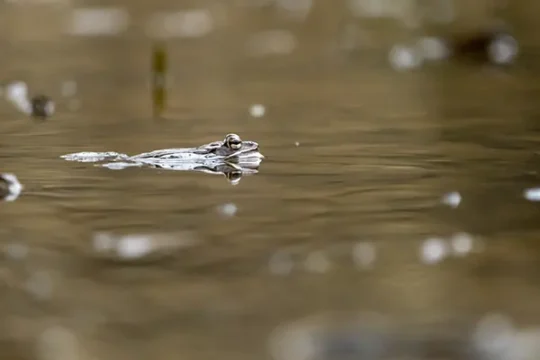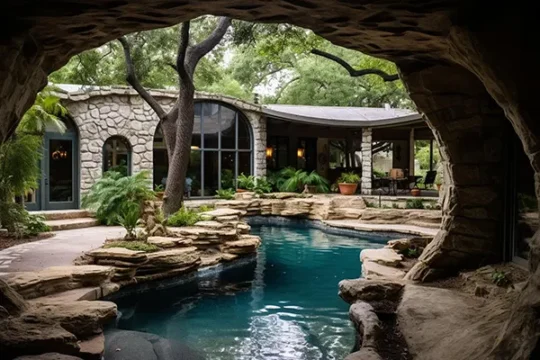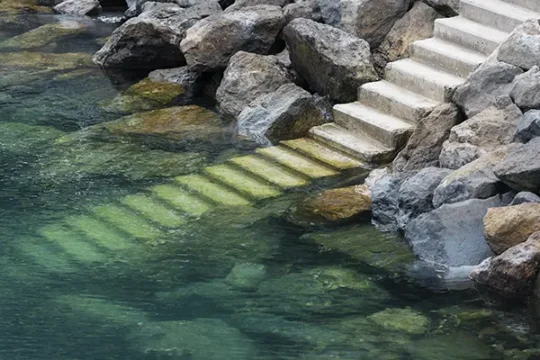TABLE OF CONTENTS
Choosing rock pool features seems straightforward until facing actual decisions. Waterfalls, slides, grottos—each creates completely different experiences and comes with distinct considerations. What looks amazing in photos might not work for specific spaces, budgets, or lifestyles.
The challenge is that these aren’t just aesthetic choices. Each feature affects pool maintenance, energy costs, space requirements, and how families actually use their pools. Understanding these differences before committing to designs prevents expensive regrets later.
Understanding Rock Pool Waterfalls
Waterfalls remain the most popular rock pool feature for good reason. They create ambiance that transforms ordinary backyard pools into resort-like retreats. The sound of falling water masks neighborhood noise, creating peaceful atmospheres even in urban areas.
Waterfall designs range from subtle single-stream features to dramatic multi-tiered cascades. Height matters significantly—taller waterfalls create more visual impact and sound but require more powerful pumps and careful structural engineering. California homeowners particularly appreciate how waterfalls enhance outdoor living spaces year-round.
Design Considerations for Waterfalls
Waterfall placement affects both aesthetics and functionality. Positioning waterfalls where they’re visible from main living areas—patios, kitchens, living rooms—maximizes enjoyment. However, placing them too close to seating areas can make conversation difficult due to sound levels.
Water volume determines character. Heavy flows create dramatic effects and louder ambient sound. Gentler streams produce subtler, more relaxing atmospheres. Many homeowners choose adjustable pumps allowing flow customization based on occasions—full power for parties, quieter settings for peaceful evenings.
Rock selection and arrangement create natural appearances. Quality artificial rock replicates natural stone formations where water would logically flow. Poor designs look obviously artificial. Experienced contractors understand how real waterfalls form geologically and replicate those patterns.
Maintenance and Operational Costs
Waterfalls require dedicated pumps separate from main pool circulation. These run continuously or on timers, affecting electricity costs. A typical residential waterfall pump adds approximately $30-60 monthly to utility bills depending on size and runtime.
Mineral buildup occurs where water contacts air and rock surfaces. Calcium deposits form white crusty layers that look unsightly. Regular cleaning prevents buildup from becoming difficult to remove. Some homeowners use water treatment systems reducing mineral content, though these add upfront costs.
Pump maintenance is straightforward but essential. Filters need cleaning monthly. Impellers occasionally clog with debris. Professional annual inspections catch potential problems before failures occur. Budget approximately $200-300 annually for waterfall-specific maintenance beyond regular pool service.
Best Applications for Waterfall Features
Waterfalls work excellently for homeowners prioritizing ambiance over active play. They create relaxing environments perfect for entertaining adults or families wanting peaceful outdoor spaces. The visual and auditory elements provide constant enjoyment even when nobody’s swimming.
Properties with elevation changes naturally accommodate waterfalls. Slopes or raised planter areas provide logical water source points. Flat yards require building up artificial elevation, which increases costs but remains achievable with proper planning.
Waterfalls complement contemporary, tropical, and naturalistic design styles. They’re versatile enough to match most architectural aesthetics when designed thoughtfully. However, they’re permanent features—removing or relocating them later is expensive and disruptive.
Exploring Pool Slide Options
Slides transform pools into active recreation centers. Kids obviously love them, but adults use quality slides more than many expect. They add playful elements encouraging pool use rather than just admiring it from poolside furniture.
Modern pool slides integrate into rock formations seamlessly. Gone are the days of obvious plastic attachments. Quality slides curve naturally through artificial rock structures, emerging from grottos or wrapping around boulders. When done well, they look like natural water chutes rather than added equipment.
Slide types vary significantly. Gentle slopes work for young children and cautious adults. Steeper slides with turns provide thrills for older kids and adventurous families. Some installations include multiple slides at different intensity levels accommodating all ages simultaneously.
Safety and Space Requirements
Slides need adequate landing zones. Water depth at slide exits must meet safety standards—typically minimum 3-4 feet for residential slides. The area must remain clear of other features, steps, or shallow sections. This affects overall pool layout significantly.
Supervision becomes more important with slides. Young children need watching constantly. Even older kids can get rowdy, creating collision risks if multiple people use slides simultaneously. Clear usage rules prevent accidents.
Physical space requirements extend beyond the slide itself. Approach areas need enough room for users to climb safely. Some slides require stairs or rock climbing holds to reach starting points. Factor these access routes into total space calculations.
Long-Term Durability Considerations
Quality matters enormously for slides. Cheap materials fade, crack, and become rough over time. Fiberglass slides from reputable manufacturers last decades with minimal maintenance. They resist California sun exposure better than budget alternatives.
Water flow systems need proper design. Inadequate water reduces sliding speed and increases friction, potentially causing scrapes. Too much water creates uncontrolled speeds leading to unsafe exits. Professional installation ensures appropriate flow rates.
Slides require periodic inspection for wear, cracks, or surface roughness. Annual professional checks identify issues before they become dangerous. Surface refinishing every 5-10 years maintains smooth, safe conditions. Budget approximately $150-250 annually for slide-specific maintenance.
Ideal Candidates for Pool Slides
Families with children aged 4-16 get maximum value from slides. These years represent peak usage when kids prioritize active play over lounging. However, many adults continue enjoying slides long after kids grow up.
Properties with sufficient space accommodate slides comfortably. Cramped installations feel awkward and limit slide design options. Adequate yards allow slides with interesting curves and appropriate approach areas.
Active families who actually use pools rather than just looking at them benefit most. If the pool primarily serves as backyard decor, slides become expensive unused features. Honest assessment of actual usage patterns prevents regrettable investments.
Discovering Grotto Possibilities
Grottos create unique cave-like spaces within or adjacent to pools. They provide shaded retreats from California sun, private conversation areas, and architectural drama impossible with other features. Well-designed grottos become favorite gathering spots.
Grotto complexity ranges from simple overhangs providing shade to elaborate cave systems with interior seating, lighting, and even hidden hot tubs. Some include swim-through passages connecting different pool areas. Others feature interior waterfalls creating rooms behind falling water.
The appeal extends beyond aesthetics. Grottos serve practical purposes—storing pool toys out of sight, housing equipment, and providing changing areas. Creative designs maximize functionality while maintaining beautiful appearances.
Structural and Engineering Factors
Grottos require serious structural engineering. They’re not simple cosmetic additions. Weight distribution, foundation support, and waterproofing demand professional expertise. Poorly constructed grottos develop leaks, cracks, or worse—structural failures.
Ventilation prevents musty odors and mold growth. Natural airflow through opening design usually suffices, but enclosed grottos might need mechanical ventilation. This becomes especially important in humid climates or heavily shaded properties.
Lighting transforms grottos from dark caves to magical spaces. Underwater lights create glowing effects. Recessed fixtures highlight rock textures. Fiber optics add starlight effects. Electrical work must meet strict waterproofing codes for safety.
Customization and Personalization Options
Grottos offer extensive customization. Interior bench seating creates conversation areas. Shelves hold drinks or decorative elements. Some homeowners install sound systems for music. Others include fire features for evening ambiance.
Theme possibilities are endless. Tropical grottos incorporate lush plants and tiki touches. Mediterranean designs use earth tones and classical elements. Contemporary grottos feature clean lines and modern lighting. The style should complement overall landscape design.
Privacy levels vary by design. Open grottos provide shade while maintaining sightlines. Enclosed versions create secluded spaces. Consider how much privacy versus openness matches your entertaining style and family needs.
Maintenance Challenges and Solutions
Grottos collect debris that doesn’t naturally flush toward pool returns. Leaves, dirt, and organic matter accumulate in corners. Regular manual cleaning prevents buildup. Vacuum extensions reach interior spaces others might miss.
Algae growth occurs faster in shaded grotto areas with reduced water circulation. Brushing interior surfaces weekly prevents establishment. Some homeowners install additional return jets improving water movement through grottos.
Professional inspections should examine grotto structures annually. Look for cracks, leaking, or deteriorating waterproofing. Addressing small issues immediately prevents expensive repairs later. Budget $300-500 annually for grotto-specific maintenance.
Making the Right Choice for Your Pool
Selecting features depends on multiple factors beyond personal preference. Budget obviously matters, but so do space constraints, maintenance willingness, and actual usage patterns.
Waterfalls excel for ambiance-focused homeowners wanting resort-like atmospheres. They add value through aesthetics rather than active recreation. Ongoing costs remain moderate. They complement most architectural styles and suit properties of various sizes.
Slides work best for active families prioritizing fun over elegance. They encourage pool usage rather than just admiration. Space requirements are significant. Maintenance is straightforward. They’re investments in family experiences and childhood memories.
Grottos serve homeowners wanting unique architectural statements. They provide functionality beyond other features—shade, storage, gathering spaces. Costs run highest for both installation and maintenance. They require adequate space and professional engineering.
Many homeowners combine features. Waterfalls flowing into grottos create stunning effects. Slides emerging from grottos look dramatic. The key is honest assessment—choosing features that match how you’ll actually use your pool rather than what looks impressive in photos.
Ready to Bring Your Rock Pool Vision to Life?
Understanding these features helps narrow choices, but nothing replaces professional guidance specific to your property. Space limitations, budget parameters, local codes, and personal preferences all factor into optimal designs.
Artificial Rockworks specializes in creating custom rock pool features throughout Orange County. Our experience with waterfalls, slides, and grottos ensures designs that look beautiful, function properly, and fit your lifestyle. We handle engineering, permitting, construction, and long-term support.
Contact us today for a consultation. Let’s discuss which features make sense for your specific situation and create outdoor spaces your family will enjoy for decades. Quality rock pool features transform ordinary backyards into extraordinary retreats—when designed and built correctly.




